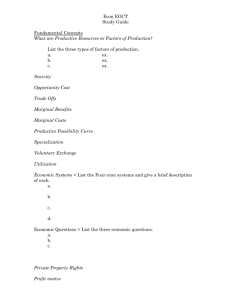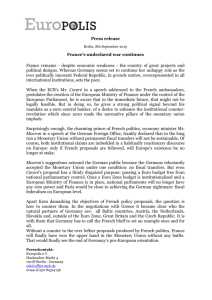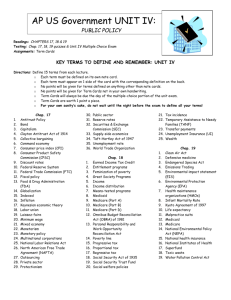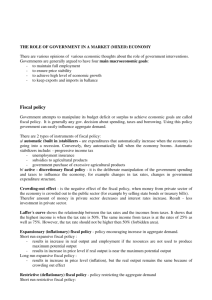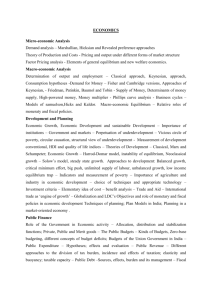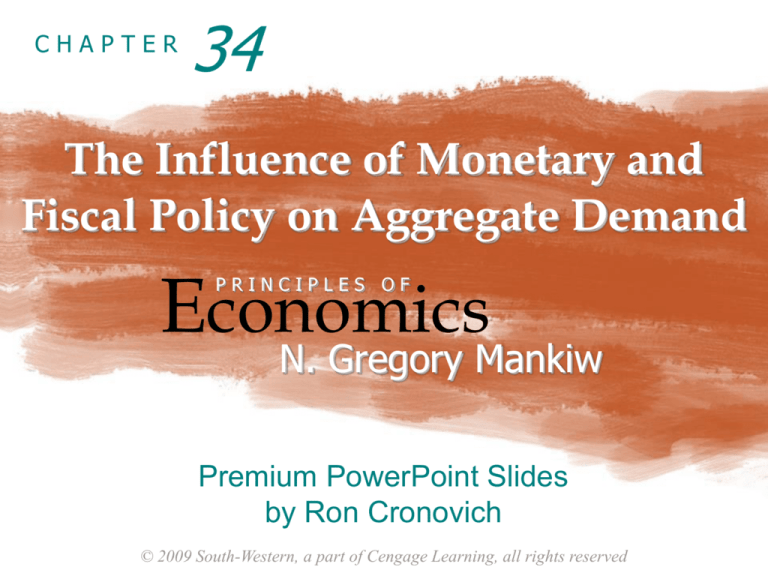
CHAPTER
34
The Influence of Monetary and
Fiscal Policy on Aggregate Demand
Economics
PRINCIPLES OF
N. Gregory Mankiw
Premium PowerPoint Slides
by Ron Cronovich
© 2009 South-Western, a part of Cengage Learning, all rights reserved
In this chapter,
look for the answers to these questions:
How does the interest-rate effect help explain the
slope of the aggregate-demand curve?
How can the central bank use monetary policy to
shift the AD curve?
In what two ways does fiscal policy affect aggregate
demand?
What are the arguments for and against
using policy to try to stabilize the economy?
1
Introduction
Earlier chapters covered:
the long-run effects of fiscal policy
on interest rates, investment, economic growth
the long-run effects of monetary policy
on the price level and inflation rate
This chapter focuses on the short-run effects
of fiscal and monetary policy,
which work through aggregate demand.
THE INFLUENCE OF MONETARY AND FISCAL POLICY
2
Aggregate Demand
Recall, the AD curve slopes downward for three
reasons:
The wealth effect
The interest-rate effect
The exchange-rate effect
the most important
of these effects for
the U.S. economy
Next:
A supply-demand model that helps explain the
interest-rate effect and how monetary policy
affects aggregate demand.
THE INFLUENCE OF MONETARY AND FISCAL POLICY
3
How r Is Determined
Interest
rate
MS curve is vertical:
Changes in r do not
affect MS, which is
fixed by the Fed.
MS
r1
Eq’m
interest
rate
MD1
MD curve is
downward sloping:
A fall in r increases
money demand.
M
Quantity fixed
by the Fed
THE INFLUENCE OF MONETARY AND FISCAL POLICY
4
Monetary Policy and Aggregate Demand
To achieve macroeconomic goals, the Fed can
use monetary policy to shift the AD curve.
The Fed’s policy instrument is MS.
The news often reports that the Fed targets the
interest rate.
More precisely, the federal funds rate – which
banks charge each other on short-term loans
To change the interest rate and shift the AD curve,
the Fed conducts open market operations
to change MS.
THE INFLUENCE OF MONETARY AND FISCAL POLICY
5
The Effects of Reducing the Money Supply
The Fed can raise r by reducing the money supply.
Interest
rate
P
MS2 MS1
r2
P1
r1
AD1
MD
M
AD2
Y2
Y1
Y
An increase in r reduces the quantity of g&s demanded.
THE INFLUENCE OF MONETARY AND FISCAL POLICY
6
Fiscal Policy and Aggregate Demand
Fiscal policy: the setting of the level of govt
spending and taxation by govt policymakers
Expansionary fiscal policy
an increase in G and/or decrease in T
shifts AD right
Contractionary fiscal policy
a decrease in G and/or increase in T
shifts AD left
Fiscal policy has two effects on AD...
THE INFLUENCE OF MONETARY AND FISCAL POLICY
7
1. The Multiplier Effect
If the govt buys $20b of planes from Boeing,
Boeing’s revenue increases by $20b.
This is distributed to Boeing’s workers (as wages)
and owners (as profits or stock dividends).
These people are also consumers and will spend
a portion of the extra income.
This extra consumption causes further increases
in aggregate demand.
Multiplier effect: the additional shifts in AD
that result when fiscal policy increases income
and thereby increases consumer spending
THE INFLUENCE OF MONETARY AND FISCAL POLICY
8
1. The Multiplier Effect
A $20b increase in G
initially shifts AD
to the right by $20b.
The increase in Y
causes C to rise,
which shifts AD
further to the right.
P
AD3
AD2
AD1
P1
$20 billion
Y1
THE INFLUENCE OF MONETARY AND FISCAL POLICY
Y2
Y3
Y
9
Marginal Propensity to Consume
How big is the multiplier effect?
It depends on how much consumers respond to
increases in income.
Marginal propensity to consume (MPC):
the fraction of extra income that households
consume rather than save
E.g., if MPC = 0.8 and income rises $100,
C rises $80.
THE INFLUENCE OF MONETARY AND FISCAL POLICY
10
A Formula for the Multiplier
Notation: G is the change in G,
Y and C are the ultimate changes in Y and C
Y = C + I + G + NX
identity
Y = C + G
I and NX do not change
Y = MPC Y + G
because C = MPC Y
1
Y =
G
1 – MPC
solved for Y
The multiplier
THE INFLUENCE OF MONETARY AND FISCAL POLICY
11
A Formula for the Multiplier
The size of the multiplier depends on MPC.
E.g.,
if MPC = 0.5
if MPC = 0.75
if MPC = 0.9
1
Y =
G
1 – MPC
The multiplier
multiplier = 2
multiplier = 4
multiplier = 10
A bigger MPC means
changes in Y cause
bigger changes in C,
which in turn cause
more changes in Y.
THE INFLUENCE OF MONETARY AND FISCAL POLICY
12
Other Applications of the Multiplier Effect
The multiplier effect:
Each $1 increase in G can generate
more than a $1 increase in agg demand.
Also true for the other components of GDP.
Example: Suppose a recession overseas
reduces demand for U.S. net exports by $10b.
Initially, agg demand falls by $10b.
The fall in Y causes C to fall, which further
reduces agg demand and income.
THE INFLUENCE OF MONETARY AND FISCAL POLICY
13
2. The Crowding-Out Effect
Fiscal policy has another effect on AD
that works in the opposite direction.
A fiscal expansion raises r,
which reduces investment,
which reduces the net increase in agg demand.
So, the size of the AD shift may be smaller than
the initial fiscal expansion.
This is called the crowding-out effect.
THE INFLUENCE OF MONETARY AND FISCAL POLICY
14
How the Crowding-Out Effect Works
A $20b increase in G initially shifts AD right by $20b
Interest
rate
P
MS
AD2
AD
3
AD1
r2
P1
r1
$20 billion
MD2
MD1
M
Y1
Y3
Y2
Y
But higher Y increases MD and r, which reduces AD.
THE INFLUENCE OF MONETARY AND FISCAL POLICY
15
Changes in Taxes
A tax cut increases households’ take-home pay.
Households respond by spending a portion of this
extra income, shifting AD to the right.
The size of the shift is affected by the multiplier
and crowding-out effects.
Another factor: whether households perceive the
tax cut to be temporary or permanent.
A permanent tax cut causes a bigger increase in
C – and a bigger shift in the AD curve –
than a temporary tax cut.
THE INFLUENCE OF MONETARY AND FISCAL POLICY
16
Fiscal Policy and Aggregate Supply
Most economists believe the short-run effects of
fiscal policy mainly work through agg demand.
But fiscal policy might also affect agg supply.
Recall one of the Ten Principles from Chap 1:
People respond to incentives.
A cut in the tax rate gives workers incentive to
work more, so it might increase the quantity of
g&s supplied and shift AS to the right.
People who believe this effect is large are called
“Supply-siders.”
THE INFLUENCE OF MONETARY AND FISCAL POLICY
17
Fiscal Policy and Aggregate Supply
Govt purchases might affect agg supply.
Example:
Govt increases spending on roads.
Better roads may increase business productivity,
which increases the quantity of g&s supplied,
shifts AS to the right.
This effect is probably more relevant in the long
run: it takes time to build the new roads and put
them into use.
THE INFLUENCE OF MONETARY AND FISCAL POLICY
18
Using Policy to Stabilize the Economy
Since the Employment Act of 1946, economic
stabilization has been a goal of U.S. policy.
Economists debate how active a role the govt
should take to stabilize the economy.
THE INFLUENCE OF MONETARY AND FISCAL POLICY
19
The Case for Active Stabilization Policy
Keynes: “Animal spirits” cause waves of
pessimism and optimism among households and
firms, leading to shifts in aggregate demand and
fluctuations in output and employment.
Also, other factors cause fluctuations, e.g.,
booms and recessions abroad
stock market booms and crashes
If policymakers do nothing, these fluctuations are
destabilizing to businesses, workers, consumers.
THE INFLUENCE OF MONETARY AND FISCAL POLICY
20
The Case for Active Stabilization Policy
Proponents of active stabilization policy
believe the govt should use policy
to reduce these fluctuations:
When GDP falls below its natural rate,
use expansionary monetary or fiscal policy
to prevent or reduce a recession.
When GDP rises above its natural rate,
use contractionary policy to prevent or reduce
an inflationary boom.
THE INFLUENCE OF MONETARY AND FISCAL POLICY
21
Keynesians in the White House
1961:
John F Kennedy pushed for a
tax cut to stimulate agg demand.
Several of his economic advisors
were followers of Keynes.
2001:
George W Bush pushed for a
tax cut that helped the economy
recover from a recession that
had just begun.
THE INFLUENCE OF MONETARY AND FISCAL POLICY
22
The Case Against Active Stabilization Policy
Monetary policy affects economy with a long lag:
Firms make investment plans in advance,
so I takes time to respond to changes in r.
Most economists believe it takes at least
6 months for mon policy to affect output and
employment.
Fiscal policy also works with a long lag:
Changes in G and T require Acts of Congress.
The legislative process can take months or
years.
THE INFLUENCE OF MONETARY AND FISCAL POLICY
23
The Case Against Active Stabilization Policy
Due to these long lags, critics of active policy
argue that such policies may destabilize the
economy rather than help it:
By the time the policies affect agg demand,
the economy’s condition may have changed.
These critics contend that policymakers should
focus on long-run goals like economic growth
and low inflation.
THE INFLUENCE OF MONETARY AND FISCAL POLICY
24
Automatic Stabilizers
Automatic stabilizers:
changes in fiscal policy that stimulate
agg demand when economy goes into recession,
without policymakers having to take any
deliberate action
THE INFLUENCE OF MONETARY AND FISCAL POLICY
25
Automatic Stabilizers: Examples
The tax system
In recession, taxes fall automatically,
which stimulates agg demand.
Govt spending
In recession, more people apply for public
assistance (welfare, unemployment insurance).
Govt spending on these programs automatically
rises, which stimulates agg demand.
THE INFLUENCE OF MONETARY AND FISCAL POLICY
26
CONCLUSION
Policymakers need to consider all the effects of
their actions. For example,
When Congress cuts taxes, it should consider
the short-run effects on agg demand and
employment, and the long-run effects
on saving and growth.
When the Fed reduces the rate of money
growth, it must take into account not only the
long-run effects on inflation but the short-run
effects on output and employment.
THE INFLUENCE OF MONETARY AND FISCAL POLICY
27



